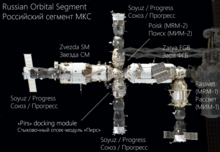Prichal (ISS module)
This article needs additional citations for verification. (February 2012) |

Uzlovoy Module also known as UM (Russian: Узловой Модуль, Nodal Module)[1] is a Russian spacecraft which will form part of the International Space Station, and later the proposed Russian OPSEK space station. Approved in 2011 and scheduled for launch in 2016, it is designed to connect modules of the future OPSEK space station.
Design
The nodal module is intended to serve as the only permanent element of OPSEK, a Russian space station intended to support deep space manned exploration missions to Mars, possibly the Moon, and Saturn. Other OPSEK modules will be replaced as they reach the end of their useful life, whilst the Uzlovoy Module will be refurbished on orbit for an extended period.
The module has six hybrid docking ports. One port is equipped with an active docking port to allow docking with the space station, while the remaining five ports are passive, enabling other spacecraft to dock with the module. The Nadir, or earth-facing, port will support automated transfer of propellants between docked Russian spacecraft and the ROS in both directions, and automated docking of manned and unmanned spacecraft using the Kurs system. The docking compartment has an internal volume of 14 cubic metres.[citation needed]
Universal Docking Module
The nodal module grew from the proposed Universal Docking Module (UDM) (Russian: Универсальный стыковочный модуль), which was a planned Russian docking module for the International Space Station, to be jointly built by RKK Energia and Khrunichev. The original design resembled the Functional Cargo Block albeit larger, and would have it docked to the nadir (Earth-facing) Zvezda service module docking port, and have four docking ports to accommodate the two Russian Research Modules and the SO2 docking compartment. Because the SO2 and a Research Module were cancelled due to lack of funds, this module was also cancelled. The one remaining Research Module was then scheduled to be fitted to the open docking port on Zvezda. Later it was also cancelled and that port was allocated to the Docking Cargo Module. DCM scheduled location was later moved to Zarya.
In the current plans the Zvezda nadir location is scheduled to be used by the Nauka module. Additionally the SO2 was put back in the plans, but relocated to Zvezda zenith location (the location for the cancelled SPP).[citation needed]
Uzlovoy Module
In the mid-2000s, RKK Energia, the manufacturer of the ROS components, again added the UM to the future configuration of the ISS. The proposal is to execute a similar to the original ISS plan with the addition of a Nodal Module (significant modification of the UDM design - to increase the number of docking ports from 4 to 6 and to take into account its location at MLM nadir - at the same time with reducing its weight from 20t to 4t and removing the additional life-support system[2]) and two additional science/energy modules to the segment around 2013-2015.[3][4] Despite its small size, this four-ton, ball-shaped module could play an extremely important role in the Russian space program.[citation needed]
The Preliminary design was completed on Jan. 15, 2011, when RKK Energia announced that its Scientific and Technical Council, NTS, conducted a meeting, which reviewed and approved the preliminary design of the Nodal Module and associated hardware. The meeting also approved the specialized launch craft, a Progress cargo ship designated the Progress M-UM and the adaptation of the Soyuz rocket for the launch of the Progress M-UM spacecraft-module.[5][6]
International Space Station
OPSEK is being constructed in orbit whilst attached to the ISS, the first element was launched in 2010.[citation needed] Equipped with six docking ports, the Uzlovoy Module would remain in orbit whilst all other modules came and went as their life span and mission required.[6][7]
The ball shaped nodal module will support the docking of two scientific and power modules during the final stage of ISS assembly and provide the Russian orbital segment (ROS) additional docking ports to receive Soyuz and Progress spacecraft, as well as additional modules.
Launch

NM is to be incorporated into the ISS in 2016.[6] It will be launched along with the Progress M-UM spacecraft; a modified Progress spacecraft which will be used to deliver it to the space station. A Soyuz-2-1b carrier rocket will be used to place it into orbit. Uzlovoy Module will be docked to the nadir, or Earth-facing, port of the Nauka module.
See also
- Orbital Piloted Assembly and Experiment Complex - proposed separation of parts of ROS
References
- ^ "В РКК "Энергия" утвердили эскиз нового узлового модуля МКС". Roskosmos. Retrieved 30 December 2012.
- ^ Russian segment of the ISS
- ^ "Russia Needs Billions More To Complete It's ISS Segment". Space-Travel.com. 14 April 2008. Retrieved 2009-01-29.
- ^ Sergei Shamsutdinov (July 2008). "Program for Development of the Russian ISS Segment" (in Russian). Novosti Kosmonavtiki. Archived from the original on 6 June 2011. Retrieved 2009-02-15.
- ^ http://www.energia.ru/en/news/news-2011/news_01-13.html
- ^ a b c Node Module. Russianspaceweb.com. Retrieved on 8 October 2011.
- ^ S.P. Korolev RSC Energia – News. Energia.ru (2011-01-13). Retrieved on 8 October 2011.
External links
- NASA assembly sequence - Updated December 8, 2006
- Space Events diary July-September 2001 .pdf - There is a paragraph stating the UDM was cancelled and to be replaced with the 70% complete FGB-2, with modifications
- FGB-2 module - An article written in Aug. 10, 2001, discussing the plans for UDM and FGB-2
Space Agency websites
![]() Russia (Energia),
Russia (Energia),
![]() Russia (Federal),
Russia (Federal),

